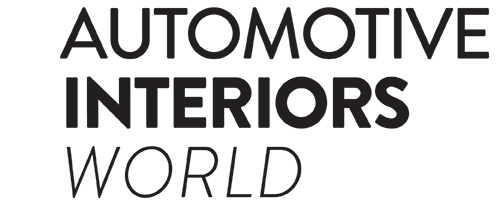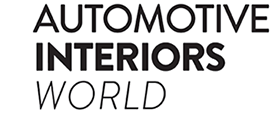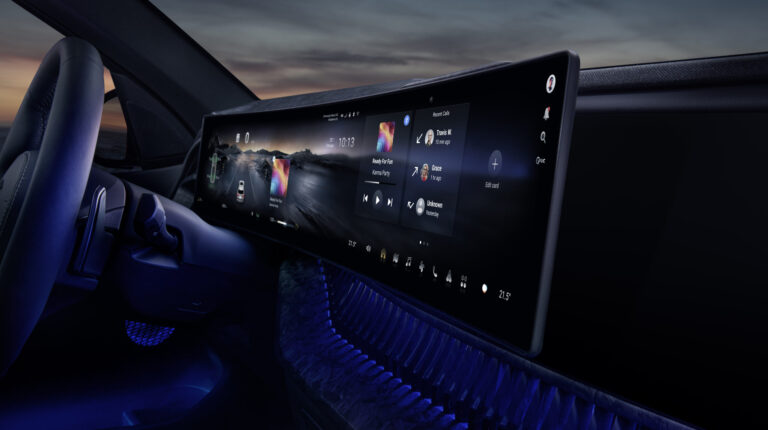The integration of next-generation technologies into everyday life once felt like a merging of science fiction and reality. Today, however, with AI and robotics becoming integral to our routines, technology has evolved into a constant companion, bridging our physical world with the digital and metaverse realms.
It was inevitable that these advances would make their way into vehicle cabins. But now the question is: how can our understanding of these cutting-edge technologies drive the evolution of software-defined vehicles (SDVs)?
Harman, an automotive technology company and subsidiary of Samsung Electronics, hosted its Harman Explore tech exhibition on May 8, 2025. At the event, the company showcased its Ready series – a suite of technologies considered to be 80% production-ready. These solutions are designed for seamless integration by OEMs, allowing them to tailor the final 20% to fit their specific needs. Central to the Ready series is car-to-X technology, aimed at redefining the relationship between drivers and their vehicles.
At the event, Harman launched its open-source, fully connected services platform, which it says will help accelerate the development of software-defined vehicles through collaboration and modular development and deployment.
The Harman open-source platform is now available as the Eclipse Connected Services Platform (ECSP) project, which is being used in large-scale production by auto makers and large fleet operators. The platform represents a pivotal moment for auto makers bringing scalable, cloud-native innovations to market, and has been designed to support connected car deployments of up to 100,000 vehicles.
“Successfully accelerating the transformation of the software-defined vehicles era requires a collaborative spirit that brings together leaders across automotive and software development,” said Heiko Huettel, VP of software products at Harman.
Mike Milinkovich, executive director of the Eclipse Foundation, added, “With advanced support for connectivity, remote management, fleet operations and data monitoring, ECSP gives automotive OEMs a powerful open-source foundation for delivering differentiated in-vehicle experiences.”
The system can provide a variety of critical functions, including reliable and secure vehicle-to-cloud connectivity, high-volume vehicle data ingestion and routing, vehicle and device management, user and identity management, streaming application enablement and vehicle telemetry. In short, the open-source system not only connects developers so that they are no longer alone during technology integration, but also enables car-to-X technology.
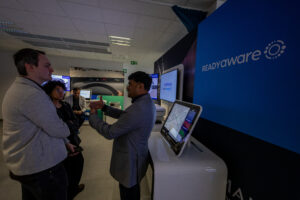
Tech suite of the future
As previously noted, Harman’s system supports the integration of various hardware and software components, offering OEMs a ready-made solution that streamlines the development process for high-tech software-defined vehicles, saving time, effort and cost. The components showcased at the event include:
Ready Aware
Ready Aware is a cloud-based, vehicle-to-network (V2N), 100% software product that provides information to drivers, such as warnings of upcoming road obstacles; alerts about traffic and traffic management, such as a countdown for a red light; and weather information. By talking with other vehicles, the system can evaluate reports made by drivers (similar to the Waze platform) and uses AI to assess the data provided by sensors that track a driver’s behavior. For example, if five cars cross over the lane divider, it can be assumed that there is an object to be avoided (Waze does not have this level of AI assessment).
Hanieffa Mohamed, project manager for the Ready Aware technology, says that when integrating with OEMs, “data is quite important”, adding, “When you cut the big animal into small pieces, we first have to talk about data and data sharing between OEMs and Harman.” The question therefore arises – how many vehicles will need to be involved for the technology to be effective?
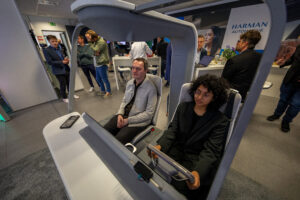
Ready Care and Ready Engage
Adding to this futuristic driving experience is the Ready Care product, a driver monitoring system that tracks attention and distractedness through machine learning algorithms and sensors and tells drivers when it is time for a break. Using the data from Ready Care, the Ready Engage solution can help drivers stay focused on the road through what Harman terms “emotionally intelligent AI interactions”.
Ready Engage introduces an emotionally intelligent augmented reality AI character into the vehicle: Luna. Luis Sagastume, senior manager of optical and mechanical engineering, explains that Luna is a cloud-based system powered by ChatGPT. Users can ask it to change a song, or tell them what the historical monument on the left was. Or it can let them know that rain is coming and suggest a calming playlist. The AI functions as a companion for the driver with complete customization and assistant qualities.
Addressing privacy concerns, Marcus Futterlieb, principal engineer in the ADAS strategic business unit at Harman International, says, “None of the data is stored. In the case of Ready Care, it makes sense for health and well-being information to be linked to your personal profile, which we call face IDs. But we don’t save your picture – we save a geometric vector of your face so that we can compare the information we have to your face and recognize you.”
Discussing Harman’s approach to data storage, he continues, “We need to store data for two to four seconds, and then we have to discard it, following GDPR compliance.” The integration of Harman technology, rather than software associated with major global technology companies such as Google and Apple, which often store data, is a matter of privacy preference.
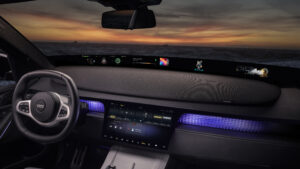
Ready Vision QVUE
Harman Ready Vision products, including the high-definition reflective QVUE display powered by Samsung NeoQLED, offer an immersive augmented reality that projects the information collected by the numerous products and communicates it with the driver. Alternatively, Ready Display offers OEMs a central Neo QLED display.
The final piece of the puzzle: audio
To create this immersive audio ‘bubble’, Harman relies on its team of ‘golden ears’ – a term used in professional audio circles to describe engineers with exceptional auditory perception. These experts work to counteract the elements that disrupt an ideal acoustic environment, the most significant being the inherent noise of the moving vehicle. According to Philipp Göppl, acoustic system engineer at Harman International, overcoming this challenge is key to achieving a true sound cocoon.
Using premium speakers from Harman’s renowned brands, such as JBL, Mark Levinson and Bang & Olufsen, alongside proprietary software, precise tuning and the expertise of its audio engineers, Harman brings this concept to life. The company collaborates with leading OEMs including Audi, Stellantis, BMW, Volkswagen, Toyota, Polestar, Renault, Aston Martin, Fiat, Bentley and Alfa Romeo.
During a demonstration at the Harman Explore event, a BMW outfitted with 32 speakers showcased the full extent of Harman’s audio innovation and engineering expertise. A standout example was the immersive thunderous sea soundscape, which used all 32 speakers, the Harman ergonomic chair to deliver a 4D sensory experience, and synchronized lighting within the vehicle. Together, these elements created an incredible cocooning environment, fully immersing passengers in the carefully crafted scene.
Conclusion
The technologies on display bring a futuristic automotive society within arm’s reach, yet one can’t help but wonder – are we running a bit late to the party? Concepts like V2N integration have been explored for years, but while Harman is clearly prepared with a wide array of advanced technologies, are OEMs equally ready to embrace them? The costs remain high, even if the innovations are undeniably impressive. So, one wonders when we can realistically expect these breakthroughs to become commonplace.
